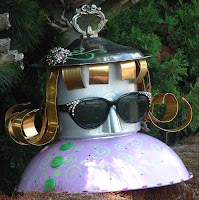BOOK INTO BOX, PT 2
Yesterday, I dug into that hardcover catalog with a box cutter and enthusiasm, and continued that task this morning.
Here are some additional thoughts on the hollowing out process.
Books are able to open because the pages slide against each other. We're going to glue the edges of the pages, which will make a nice solid box with pages that no longer slide. That means that your hole will need to start right at the front of the book, or within a few pages. The front cover will be your box's lid, and with only a few pages, or none, glued to it, will open and close easily.

The pages slide against each other
You can follow the margins of the book for your hole, or, as I did without thinking about it, you can make one margin wider. That would give you a place to put a title or additional decoration inside, or even room to cut another, smaller hole.
I've considered both options, and thought about what I'd use the smaller hollowed out compartment for. I could create a stash for an ink pen, and put a note pad in the larger one, or I could cut a rectangle the perfect size for the watch Grandpa gave Grandma when they got engaged, nearly eighty-five years ago. As you can tell, there are all kinds of things you can do with the extra space inside the book.
Now for the next step. If you haven't protected your work surface yet, this is a good time to do that.
You want to solidify the sides of the box. What you'll need to do that is glue and water. I used wallpaper edge glue because that's what was handy, but any kind of water-based household glue will do the trick. You're going to paint the glue on the outside edges of the pages, which is why you need water. The glue needs to be thinned enough to do that.

Pour a little of the glue into a small bowl, and add a little water. I use a table knife to mix because I can scrape the blade on the bowl's edge. Put enough water in the glue to make a liquid that will paint easily with a soft brush

but not too much. Glue that is too thin will make the paper buckle.

Warped edges from over-thinned glue
As you can see, I had a little problem with that. If it happens to you, don't despair. The next step is to weight the book down. I used a concrete paver. If your weight is something like that, put newspaper between it an the book, to protect it. (The book, not the brick!) I sat it on top of the closed book, but its weight alone wasn't enough to take out the buckling, so I gave it several hard pushes down with the heel of my hand. I felt like I was giving the book CPR, but that did the trick! Still, it wasn't quite as smooth as I wanted it to be, so I gave it a few swipes with a small wire brush. It looked all right even without that step, though.

Squashed, compressed into its former flatness
Leave your book to dry, and go do something else. Suggestion: Start thinking about how you want your finished book to look, if you haven't already started. That's our third and final step.









































.JPG)

























































3 comments:
I've always wanted to try...I mean succeed..at this! I've ruined many a book when I was little slicing the pages up not knowing what I was doing trying to make a hidden compartment. Great how-to photos!
I too have always wanted to do this, I tried it once when I was probably ten years old and you can imagine, it was a big sticky mess and it didn't work.
I might just attempt it again and use your blog as my guide!
Thanks, Jamie and Babes of Babyhoot! I just hope I get it right, lol. Trying this without instructions is a tad worrisome, but so far it's working.
Post a Comment